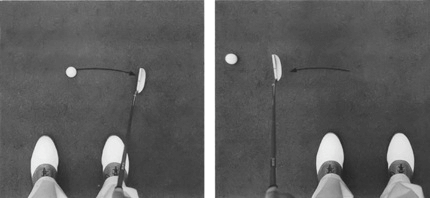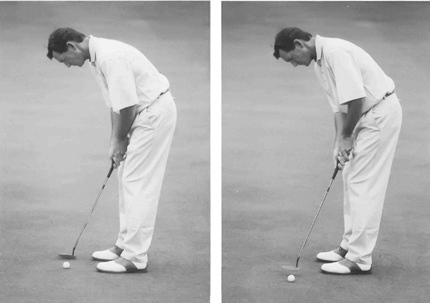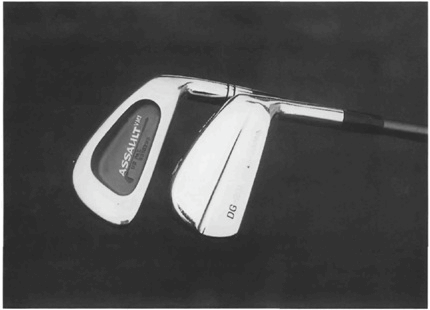A good worker never blames his tools, they say, but that isn’t the case in golf. Your clubs need to be specific to your needs.
Here’s what to look for in a golf club:
1. Shaft flex – A shaft that is stiff for your swing will cost you distance. A shaft that is “whippy” will tend to make you less accurate than you could be.
2. Grip circumference – If a grip is thick or thin, the ability of your hands to work properly during the swing will be affected. That’s important. Your hands are your only points of contact with the club, which is what makes contact with the ball.
3. Driver loft – In a misguided attempt to hit lower shots and/or gain yardage, most golfers use a driver that doesn’t have enough loft. More loft means less sidespin which means greater accuracy. And, invariably, doesn’t cost you much in the way of distance.
4. Set Makeup – Are you making the most of the fourteen clubs that the rules of golf allow you? There are many different factors. But the common factor is that any mistake in your clubs has to match up with a mistake in your setup and/or your swing.
5. Shaft length – Shafts that are short will cause you to bend over too much and stand too close to the ball. Shafts that are long will force you to stand too tall and too far from the ball. Either way, the plane of your swing is going to be affected.
6. Lie – A club that sits too upright means your hands will be too high at address. A club that sits too flat leads to your hands being too low at address. Again, your swing will have to compensate for either.
Let’s take a further look at each.
Table of Contents
1. Shaft Flex
If another club goes further than yours, check both the lofts and the length and flex of the shafts. How far you hit the ball and how fast you swing determines what shaft flex is best for you.
For most amateurs that means a shaft that has a regular flex. The average golfer I see on the range swings a driver at about 85 mph. That’s a long way behind the professionals. The minimum swing speed on the PGA Tour is around 110 mph. Tiger Woods and John Daly are up at about 140 mph. That’s a huge difference.
There are two factors in determining the shaft flex best for you:
- clubhead speed
- tempo
Someone with a slow, smooth swing—Fred Couples, John Daly—and great speed through impact doesn’t need as stiff a shaft as someone with a fast action—Nick Price, Lanny Wadkins.
Nick and Lanny have very stiff shafts in their clubs. Because they change direction from backswing to downswing so quickly, their shafts tend to “lag.” So they need stiffness.
Find yourself in the following categories:
- Slow and easy swing—regular shaft
- Slow clubhead speed, quick tempo—regular-stiff shaft
- Fast clubhead speed—stiff shaft
- Fast clubhead speed, quick tempo—extra-stiff shaft
In general, your clubhead speed can be guessed at from your distance. And you’ll already know if you have fast or slow tempo. The slower your tempo, the weaker the shaft. A faster tempo needs a stiffer shaft.
Shaft flex also affects curvature and ball-flight. A soft shaft is best if you are looking for more distance. Stiffer shafts tend to help your accuracy. So, if you are accurate but short, get softer shafts.
2. Grip Size
These days there are many different types of grips for you to choose from. Some are better in cold weather; some in hot weather.
I find cord grips perform better in hot weather but they are hard on your hands. Softer grips give you a firmer hold in cold weather, but they are often difficult to hold on to in sweaty summer conditions. There are no rules.
Go with what you feel is most comfortable/practical for you. Grip size is also important because it affects how your hands work in the swing. The thicker the grip, the less you will tend to use your hands.
Which can lead to sliced shots. And the opposite is true. A thinner grip will encourage hand action through impact and could lead to more hook. Once again, look at your ball-flight for clues.
If you have big hands but you slice the ball, you might want bigger grips, but not too big. Grips that are big will make it hard to fix your slice.
Alternatively, if you have small hands, then you might need a smaller grip. But if you already hook the ball, take care. If the grip is thin, your hook will be hard to get rid of.
3. Driver Loft
This is very important. Most people have drivers with shafts that are too stiff and faces with not enough loft. That fact is especially true of sheers, the single biggest subset of golfers.
People who slice tend to hit the ball high. For two reasons. One, the clubface is open at impact. And two, the clubhead is coming into the ball at too steep an angle.
So what do most slicers do? They buy a straighter-faced club in a misguided attempt to hit lower shots. A straighter face will only cause more and bigger slices. More loft means more backspin, which counteracts sidespin. So if you think that less loft means more distance, think again.
What a seven-degree driver will give you is more slice or hook, not more yardage. The trouble is, it’s hard to find the right loft. There is no single answer for you, me, or anyone else. Because every club manufacturer is different.
The way the weight is distributed in clubs might mean you need ten degrees in one, eight degrees in another. But the ten-degree club will always give you straighter shots. Ideally, you need to get the club with the most loft that still produces the optimum trajectory for you.
If you don’t have enough loft, your shots will curve more. So you will tend to swing in the opposite direction to compensate. It’s always better to have a little more loft, especially on your driver.
Think about it. If you’re like everyone I know, you tend to hit your 3-wood and 5-wood straighter than your driver. The increased loft is the reason why.
4. Set Makeup
Choosing Your Wedges
Beware of the club manufacturer’s favorite trick. In an effort to make you think you are hitting the ball longer, they reduce the loft on your clubs. For example, a 6-iron today is about four degrees stronger than thirty years ago.
That’s a whole club difference and the reason why you have a big gap between the pitching wedge and the sand wedge at the end of your set. For the pitching wedge to work as it was originally designed, it needs at least fifty-two degrees loft.
Nowadays some have forty-seven degrees. That’s a big gap compared with the normal four- degree progression. And why every manufacturer now sells a “gap” wedge.
The evolution of the gap wedge was inevitable. As soon as one club maker bent their clubs stronger, everyone followed suit. And as soon as one club was strengthened they all had to be. It is, after all, better to have a gap at the end of the set rather than in the middle somewhere.
A pitching wedge is the easiest club with which to hit a less than full shot.And even if you can’t develop that shot you can always get a gap wedge.
Not long after the third wedge became acceptable, along came the lob wedge, one with as much as sixty-two degrees of loft. It became popular because people have a hard time getting the ball in the air and stopping it quickly. Suddenly that was much easier.

Carrying three wedges means having to hit fewer “in-between” shots.
Carrying three wedges does give you other benefits. Because you have to hit fewer half and three-quarter shots, gauging distance is easier. More often than not you can go ahead and make a full swing.
Especially if you are smart about laying up to specific yardages. The top pros all do that. They want to hit a full shot into the green, not some fiddling little half shot.
That’s why knowing your distances is really important. Years ago Tom Kite—one of the best wedge players in the game—had his father out on the range with a walkie-talkie.
He would tell Tom where each ball landed, which gave him the feedback he needed to judge how far to hit each shot. He had a feel for how hard to swing each time.
As well as following Tom’s lead, you need to know what to use from 150 yards. Then there is about an 8–10 yard difference with each club.
Choosing Your Fairway Woods
Here’s something that may shock you. If you are like most golfers, you should have at least four, maybe five, fairway woods in your bag. Forget your long irons; they are just too hard to hit consistently well.

Most golfers should carry five fairway woods; long irons are just too hard to hit.
Follow the lead of the Senior Tour players and LPGA pros. They are a little bit shorter than the big guns on the PGA Tour. Those guys are so strong and powerful they only need a couple of woods in their bags.
Only on special occasions at Augusta during the Masters, for instance would you see some of them using a 4-or 5-wood.
Seniors and women pros, although they hit the ball a long way, are more comparable to you. They use more fairway woods. Annika Sorenstam, the best woman player in the world over the last few years, has nothing longer than a 5-iron in her bag. She uses five fairway woods.
Fairway woods are easier to hit because the bottom of the club is designed with some forgiveness in mind. They are a bit like sand wedges. If you have a decent lie you can hit a sand wedge behind the ball a little and still hit a semi-decent shot.
The club “skids” into the ball and builds in some margin for error. Fairway woods are the same way. They are designed to glide or skid across the turf. And they have a lower center of gravity, which helps you get the ball up in the air. All of which makes them easier to hit.
Most people have all kinds of trouble getting the bottom of their swing in the right place. So they have trouble hitting the ball and the turf at the same time.
But a fairway wood allows you to hit a little behind the ball and still get away with it. In contrast, with a long iron in your hands you have to be precise. You have to hit right on the ball.
If you’re not capable of hitting a drive 275 yards, you shouldn’t be using a 1-iron. If you can’t hit a drive 260 yards, you shouldn’t have a 2- iron in your bag. If you can’t drive it 245 yards, you shouldn’t use a 3- iron. If you can’t hit a drive 230 yards, you shouldn’t carry a 4-iron.
That is a pretty good rule of thumb. Eliminate irons as you go. A fairway wood will also produce a better trajectory. The more loft you have, the more backspin you get, which means less sidespin, and the straighter you will hit the ball. More consistent. More solid. Straighter.
All in all, a pretty good combination. If you don’t swing fast enough, you can’t hit long irons. To hit long irons well you need a lot of clubhead speed and you have to be very precise at the bottom of the swing. Not to mention they’re harder to hit straight. That’s three strikes. So they’re out.
Choosing Your Putter
Personal preference plays a big role here. The length of your putter and the lie of your putter are determined by the way you set up to the ball.
The more you bend over, the better you will tend to be on short putts, not so good on long putts. Standing up, farther from your work, gives you a better view of the line on long putts, as well as a better feel for distance.
But those are generalities. Nowhere in golf is there more margin for error than in putting. Much of the time you should simply do what you feel comfortable doing.
What I will say is that your style should match your putter. There are many different types of putters. Heel-and-toe-weighted putters. Heel- shafted putters. Center-shafted putters.
If you are like Ben Crenshaw in that you like to feel the putter swinging open to closed, you will be best served by a heel-shafted putter
A heel-shafted putter naturally creates an in-to-square-to-inside stroke shape.

If you try to keep the face square like Tom Watson, get a center- shafted putter.
Be aware that all putters have loft; somewhere between three and seven degrees. The more loft you have, the more the ball rolls on top of the grass. On real shaggy greens you want a more lofted club; on fast greens less loft.

If you like to make a straight-back-straight-through stroke, use a center-shafted putter.
But again, it depends on your style. If you like to have your hands ahead of the ball at address, you might want a putter with more loft. If your hands are more even with the ball, you’ll need less loft on your putter.
5. Shaft Length And Lie
The length of your back, arms, and legs are all factors in how long your clubs should be. But the most important aspect is the distance between your knuckles and the floor when your arms are hanging by your sides
Fingertips to floor is no good because you might have unusually large hands. Small or big hands and/or short or long fingers can skew the measurement. Besides, either or both indicates you need a different grip size, not shorter or longer clubs.
The first indication that something needs to be done about the length of your clubs is a faulty posture. Lie and length influence your posture. And your posture influences the plane of your swing and your ability to pivot your body correctly. So it follows that the lie of the club and the way that the clubface hits the ground influences the way the ball takes off and flies.
As a general rule, the lie angle should range from the mid 50 degrees for drivers, to the mid 60 degrees in short irons. As for irons, the range averages between 59 to 60 degrees. The lie angles for putters reach into 70s
Cavity Back Vs Blade
Cavity backs distribute the weight around the heel and the toe and up and down on the club. There is no reason not to play these clubs. Some people say they like blades because they give them more feedback when they miss it.
That makes no sense to me. The ball will give you plenty of feedback. You want better misses, not to tell when you’ve got a miss. Today’s clubs are just better designed. They give you a lot of help. You can hit the ball all over the clubface and get away with it.
You can still get your shots airborne and get good distance. As for blades—even tour pros don’t use them nowadays. Or at least a very low percentage of them. If you are not using cavity-back clubs you are not using the equipment that will be the most help to you
Cavity-back irons (left) will help your game more than blades (right).

Forged clubs and blades are easier to hit for certain shots—in the wind they keep the ball down because there isn’t as much weight in the bottom of the club. And you can curve the ball easier. But those are situations geared toward better players.



